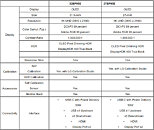Friday, December 17th 2021

2022 LG Ultrafine OLED Pro Monitors for Creatives Set New Standards for Picture Quality
LG Electronics USA is once again setting higher expectations for professional-grade display solutions with the announcement of its 2022 LG UltraFineTM OLED Pro monitors (models 32BP95E, 27BP95E). Delivering the advantages of OLED's self-lit pixels to the desktop, the monitors provide the accurate color reproduction and superb HDR and SDR performance that professional visual effects artists, video editors and other creative industry roles demand.
LG's newest 32- and 27-inch OLED Pro models delivers 4K UHD resolution (3,840 x 2,160) screens with a 1,000,000:1 contrast ratio and 99 percent coverage of the DCI-P3 color gamut, making them suitable for even the most detailed digital projects. Both new displays offer independent pixel control for impressive color fidelity and contrast and because OLED displays do not require backlighting, these UltraFine monitors are free of the distracting halo effect, or blooming, common on many LCD displays.To ensure that these models display vibrant colors as intended under the conditions optimal for productivity, both OLED Pro monitors come with detachable self-calibration sensors and monitor hoods. When used with the free-to-download LG Calibration Studio software, the calibration sensor measures the light emitted from the display at times predetermined by the user and automatically makes the necessary adjustments to maintain a high degree of color accuracy and consistency. For even more color and image accuracy, the hood can be attached to prevent distracting reflections and glare from external light sources.
Both UltraFine OLED Pro displays offer slim, elegant form factors and are light weight for easy relocation to different rooms and desks. The included stand attaches securely to the rear of the display with a simple One-click mechanism and offers adjustability for height, pivot and tilt without sacrificing stability or style.
"Designed with creative professionals in mind, our new UltraFine OLED Pro monitors deliver sheer visual precision with stunning self-lit picture quality and reliable calibration," said Seo Young-jae, senior vice president and head of the IT business unit of LG Electronics Business Solutions Company. "The incredible accuracy, wide color gamut and ability to faithfully reproduce both HDR and SDR content make these premium display solutions ideal for professional users working in the film and digital media industries."
The new LG UltraFine OLED Pro monitors will be available in key markets worldwide starting next month.
Source:
LG
LG's newest 32- and 27-inch OLED Pro models delivers 4K UHD resolution (3,840 x 2,160) screens with a 1,000,000:1 contrast ratio and 99 percent coverage of the DCI-P3 color gamut, making them suitable for even the most detailed digital projects. Both new displays offer independent pixel control for impressive color fidelity and contrast and because OLED displays do not require backlighting, these UltraFine monitors are free of the distracting halo effect, or blooming, common on many LCD displays.To ensure that these models display vibrant colors as intended under the conditions optimal for productivity, both OLED Pro monitors come with detachable self-calibration sensors and monitor hoods. When used with the free-to-download LG Calibration Studio software, the calibration sensor measures the light emitted from the display at times predetermined by the user and automatically makes the necessary adjustments to maintain a high degree of color accuracy and consistency. For even more color and image accuracy, the hood can be attached to prevent distracting reflections and glare from external light sources.
Both UltraFine OLED Pro displays offer slim, elegant form factors and are light weight for easy relocation to different rooms and desks. The included stand attaches securely to the rear of the display with a simple One-click mechanism and offers adjustability for height, pivot and tilt without sacrificing stability or style.
"Designed with creative professionals in mind, our new UltraFine OLED Pro monitors deliver sheer visual precision with stunning self-lit picture quality and reliable calibration," said Seo Young-jae, senior vice president and head of the IT business unit of LG Electronics Business Solutions Company. "The incredible accuracy, wide color gamut and ability to faithfully reproduce both HDR and SDR content make these premium display solutions ideal for professional users working in the film and digital media industries."
The new LG UltraFine OLED Pro monitors will be available in key markets worldwide starting next month.



20 Comments on 2022 LG Ultrafine OLED Pro Monitors for Creatives Set New Standards for Picture Quality
Is LG gonna respond with something?
Let's see what that is actually going to be ;) Its misty as hell, that tech... and Samsung isn't exactly known for not misleading us with display tech. I genuinely hope they found the monitor OLED grail... but let's see.
Either way its fantastic to see OLED in smaller display diagonals. Now we're getting somewhere.
I have no interest in oled, maybe the samsung qd-oled stuff changes things, I have no interest in a disposable monitor (regular oled)
theappliancesreviews.com/the-evolution-of-qled-and-oled-technologies-in-hybrid-qd-oled-technology/amp/
Some TL DR : QD Oled will have higher brightness and uses only a self emissive blue light source. The QD filter does the rest. So it remains to be seen how the image compares to LG OLED. Could be a winner. Could also just be yet another poor contrast panel. Its already known the black in QD Oled is not 'zero light' and static contrast is not infinite.
I mean LG OLED is a white OLED with a color filter sandwich, which shouldn't be any different and yet it has a perfect net zero black.
Larger OLED also would explain why black isn't black, the OLEDs don't turn off per pixel, but would probably be more akin to local dimming/zones.